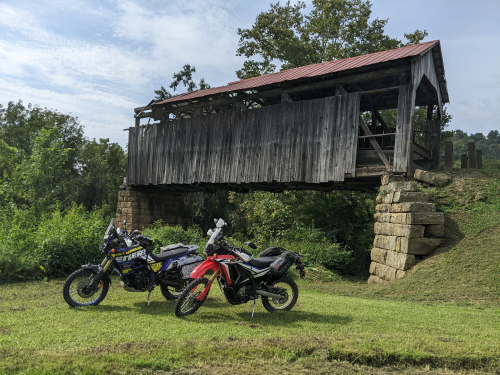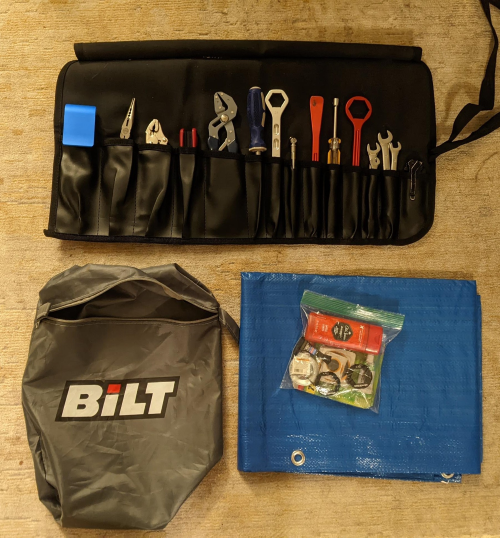
A couple of summers ago, a buddy of mine and I decided to meet each-other in Ohio to do some offroad riding around the Ohio-West Virginia border, namely in Marietta. The place was close enough to make riding there in half a day doable on a dual sport, so I decided to take my CRF 250 and ride down from Ann Arbor. I had never ridden one of my bikes for more than a couple hours and needed to do a little to prepare for the trip the month leading up to it. Despite my efforts, there were just a lot of things that still went wrong and equipment I wish I brought: I hope jotting some of this down can prepare others for such ADV trips - even short ones.
The first part of the trip was relatively uneventful: my biggest challenge was keeping up with traffic on my little 250, which would top out around 72-80 mph depending on there being a head/tail wind or a hill. Despite this, the first part of the ride wasn’t too bad considering I was close to sea level the whole time (the windshield clip-on I bought also helped a lot with wind buffeting).
In the last 100 miles or so I encountered a bad flat tire that set me back like 2-3 hours. My biggest mistake here was not bringing a spare inner tube, or I should say, not replacing the one I used a month earlier on the same bike. I didn’t come completely unprepared: I brought a patch kit and even brought the tools to take the tire off (made easier by my friend driving up to help), but I didn’t anticipate a 3-inch gash in the innertube thanks to a newly added deck screw in the tire. Luckily, the folks in south Ohio were very nice with many stopping to ask if I needed help and one even giving me a ride to the local Honda dealer to get a tube and to pick up his air compressor to speed the job up (an upgrade over my bicycle hand pump). I’d say the lesson here is to go tubeless and carry a plug kit or always carry spare tubes (at least a front tube at minimum so it can fit both wheels in a pinch). Also bring a handheld electric air pump you can plug into your battery.

While I had enough tools to do the job, I really wished my kit was a little more organized: I had taken a hodge podge of wrenches and drivers from my toolbox and threw them in a bag. This made the kit heavy, specific tools hard to find during poor lighting, and made keeping sensitive parts clean like through-axles a challenge. I’d say buy a complete toolset of just what your bike needs and put it all in a tool roll with a small tarp to keep parts organized as well as clean. Also, pack some soap to lubricate a tire to put it back on the rim or to clean any cuts you get from wrestling with bigger repair jobs.
After continuing to our hotel in Marietta and starting our ride the next day, we started exploring the dirt trails we came for. My bike’s lack of power made some of the hill climbing on steeper ascents in West Virginia a little sketchier but made the tight single tracks and descents less so. My CRF was a deal when I bought it so I don’t regret getting it, but I would suggest a newcomer to adventure riding to upgrade to something like a DRZ400 despite the lack of features just for the power bump (without adding too much weight). Regardless, both of us had fun and only needed to turn around a couple times from muddy trails. A curious pattern I found was that people always wanted to stop by and chat: I guess there’s just something about two wheels and loud noises in the middle of nowhere that make people curious.
I would have liked to say getting a dedicated navigation unit was worth it, but honestly, I think just using a phone on a RAM mount would have been ideal. I know the vibrations, water, and direct sunlight are not great for smartphones, but they’re all rated for underwater and dust proofing to some degree these days and using your phone’s native apps instead of the Nav/GPS maker’s app as a middleman is more flexible (even just getting GPX data into the TomTom I was using or answering a phone call was an exercise in patience). I ended up relying on my friend’s navigation for the offroad portions mostly because he was nimbler just using his phone directly during detours or discovering new trails.

Roughly a month in advance, I installed some crash bars and handguards to protect the bike in case of a fall. I had heard enough horror stories of snapping clutch levers off or brush jamming brake levers on long trips to think it would make a good investment. While these made my relatively svelte CRF weight a bit more, they ended up being used a lot in the slippery mud and loose gravel. If you do plan on going offroad, I will absolutely recommend armoring up the bike like this if you care about not needing to jerry rigging broken clutch controls with vise grips or protecting your expensive fairings (which there’s a lot on the Rally). It also gives you a little more confidence in taking your bike to places that you might not otherwise try exploring…although this brings me to my next point.
Both of our bikes had crash protection, so we decided on trying sketchier terrain that was borderline bog-like. However, I would never attempt some of this riding without a friend in retrospect. These trails were certainly doable with ATVs or side-by-sides, but constant ruts, slippery mud, deep puddles, and steep grades in the Appalachia led to the bikes being dumped frequently and needing two people to haul them out. While it was fun driving around like Scooby Doo and watching my friend get yeeted into waist deep puddles, picking up a bike with an extra 60-100 pounds of equipment stuck in a mud hole would be miserable by yourself if not impossible. This was almost certainly the case with my friend’s heavier Tenere: while I was jealous of the 700cc’s of power going up hills or hitting highways, I certainly appreciated my CRF’s comparatively light weight in the trickier stuff. The lesson here is the extra confidence can work both ways and it’s probably a good idea to bring a friend if you want to push your limits, especially on bigger bikes.
One thing I didn’t really learn until I got back to Michigan and got to clean the bike down was how damaging soft luggage can be to fairings and paint work. I originally bought some Tusk bags that tie down to the mud guard and drape over the rear seat. They had some nice rubber pads to help protect any plastic they touched, but this ended up just being a trap for grit in dirtier trails that scoured the plastic instead. I prefer soft bags over hardcases to prevent getting trapped under the bike from a fall, but I didn’t like how they acted like sandpaper during real riding. I’d suggest sticking to soft cases but attaching them to a luggage rack on the bike instead to get them away from the bike itself (it also allows you secure more stuff ad-hoc such as soaked riding gear or broken parts).